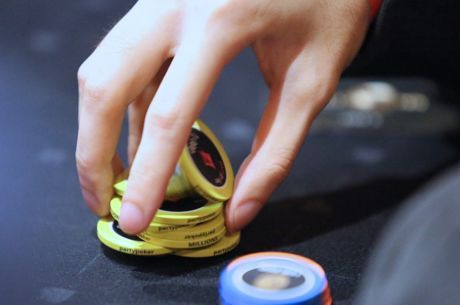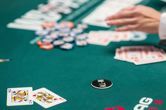His and Hers Poker: Adventures in Range Splitting

Hello, Poker Friends! This week, we are going to give you a bit of a thought exercise on a more technical topic �� how to split your ranges on different streets and the consequences of doing so.
The Table and Villain(s)
It's Saturday afternoon at a Borgata $2/$5 table. Hero (Matt) has had a good session so far and has run up a big stack. The Main Villain for this hand is a Borgata reg and also a regular listener to the His and Hers Poker Podcast. That of course means he is a thinking player who is looking to study and improve his game.
Villain and Hero have played quite a bit over the last several months. Villain is highly aggressive, which often is very profitable for him as it helps him win pots from timid players. However, Villain has a tendency not to dial that aggression back enough against better opponents. Villain's preflop opening range is quite wide from all positions, in keeping with his aggressive style. He also tends to call three-bets with a very wide range.
Effective Stacks: ~$1,500 (Villain).
Preflop
Action
The Villain opens to $25 from under the gun. The action folds to Hero in the hijack seat. Hero has A?Q? and three-bets to $75. It folds back around to the Villain who calls.
Analysis
At low stakes, there are often some nitty players whose under-the-gun opening range is so strong you should perhaps contemplate having almost no three-betting range against them. This Villain is certainly not one of those players. We want to develop a three-betting range against Villain, but what should that range look like?
When selecting a defending range structure, our primary decision is polarized versus linear. In brief, a polarized range contains three elements:
- a "value" three-betting component at the top of our range;
- a range of hands just under that with which we will just call; and
- a range of hands just under the calls which we will use as "light" / "bluff" three-bets.
By contrast, a linear range only has two components:
- a three-betting component at the top of our range; and
- a range of hands just under that with which we will just call.
Sometimes we may wish to have a range that is so linear that it actually contains no calling component whatsoever (i.e. you only three-bet or fold).
When do you use each variety of range? In general, you want to adopt a more linear range against opponents whom you feel are overdefending versus your three-bets. If your opponent is going to defend with an overly wide range, you want to make sure that your three-betting range is ahead of their defending hands.
Against the Villain in this hand, who opens wide and who is a notably wide three-bet defender, we should adopt a linear range in which A?Q? is a three-bet. Against a tighter player with a stronger opening range, A-Q-offsuit will often work better as a call in a polarized defending range.
Flop
Action
With $157 in the pot, the flop is J?7?5?. The Villain checks. Hero bets $60 and Villain calls.
Analysis
Hero's top-heavy linear three-betting range doesn't have a ton of interaction with this relatively low board. When this occurs, it is very difficult to find a way to split up Hero's range in a traditional fashion.
The problem is that Hero doesn't have enough good bluffs to balance out his value hands. Hero has some flush draws, but not many. He also has no combos which make for a straight draw.
An elegantly easy way to handle this situation is to perform what is called a range bet. This is a rather small bet which Hero makes with his entire range of hands. On this board texture, Hero could opt to range bet something like $60 with absolutely everything that he three-bet preflop.
Turn
Action
The pot is now $277. The turn brings the 9?, for a turn board of J?7?5?9?. Villain checks and Hero checks behind.
Analysis
The effect of range betting on the flop is that Villain's range gets filtered down, while Hero's range does not. In other words, we know that Villain has a hand which he felt was good enough to call with on the flop. As a result, it is probably now time to split Hero's range on the turn. We should do so in an exploitative fashion, since we don't suspect Villain is particularly balanced.
We will bet for value with things like our overpairs. We will also bet as a bluff with the few flush draws which we have in our range. However, a key question is what holdings do we check on the turn with the intention of calling off on a blank river?
This raises a dilemma. We suspect that Villain's wide range contains quite a few weak jacks. That means that we are going to want to bet our hands like A-J and K-J for three streets of value. However, using those holdings as turn value bets leaves few holdings to defend Hero's check-back range.
That's not a problem against passive opponents who will never bluff the river. In this hand, however, we are against a Villain who may fire on the river with a ton of air which he floated with on the flop to our small bet sizing.
This is not an immediate reason to start missing out on value by checking back A-J and K-J on the turn. Instead, Hero must be very conscious of how wide he is going to have to defend on the river after exploitatively betting with most all of his good value combos on the turn.
River
Action
After both players check the turn, the pot still contains $277. The river is the 4? for a final board of J?7?5?9?4?. Villain bets $175. Hero tanks for quite a while before finally calling. Villain tables A?6? and Hero wins with his A?Q?.
Analysis
It is here that Villain makes a small, yet very meaningful bet sizing error. Villain's range has a ton of jacks. However, we should suspect that Villain would make a smaller bet if he were trying to get thin value with a jack. Villain's bet of $175 seems a touch polarizing. In other words, he seems to be representing either a premium holding or complete air.
If Villain bet something like $125, we could comfortably fold under the weight of all of the single pairs in his betting range. When Villain bets $175, however, he removes most of the single jacks out of his betting range and leaves Hero with a real decision. As such, Villain's error here was trying to bet too large to apply fold pressure. That kind of move is great against unobservant opponents, but you want to keep a sharp eye on what your bets do to your represented range when you are against someone more sophisticated.
Even so, Hero must still decide whether he is going to hero call with ace-high. Against a more balanced opponent, A?Q? is probably a fold. Even if we burned all of our J-x hands on the turn as value bets, we still have T-T and A-K as better defends. We particularly want to use combos which don't have a diamond, as those increase the chance that Villain has a busted flush draw. So, against a balanced player (even an aggressive one), this would be a fold.
However, we suspect that this overaggressive Villain may well be firing here with legitimately any two cards which he floated with on the flop. Against such an opponent, we need to decide if a call is mandated all the way down our range to A?Q?.
The Takeaway
Determining if A?Q? was a correct call here is a highly technical exercise and would rely heavily on our assumptions about Villain's flop calling range. The point of this article is not so much to determine what you would do with this one particular holding, however. Instead, it is meant to have you think about how your actions on each street influence your ranges.
Specifically, we see on the river that there may be some spots where you need to defend quite wide with some unconventional holdings, simply because more traditional defending candidates were removed from your range on prior streets.
His and Hers Poker is a free, weekly strategy podcast hosted by Matt and Tracey Waldt. They are a married couple who play live cash games on the East Coast. Their podcast focuses on providing practical advice about hand reading, with an emphasis on how to identify and exploit the common leaks and imbalances of low-stakes players. His and Hers Poker can be found on iTunes, Google Play and other podcast services. For more information, and to subscribe, please visit hisandherspoker.com.









